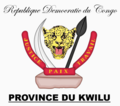Kwilu | |
|---|---|
| Province du Kwilu | |
 | |
 | |
| Coordinates: 5°2′S18°49′E / 5.033°S 18.817°E | |
| Country | |
| Established | 2015 |
| Named after | Kwilu River |
| Capital | Bandundu |
| Largest city | Kikwit |
| Government | |
| • Governor | Philippe Akamituna [1] |
| Area | |
• Total | 78,219 km2 (30,201 sq mi) |
| Population (2024) | |
• Total | 6,898,105 |
| • Density | 88.190/km2 (228.41/sq mi) |
| Ethnic groups | |
| • Native | Bayanzi, Basuku, Badinga, Bakwese, Basonde, Babunda, Bapende, Balunda, Bahuana, Bambala |
| Time zone | UTC+1 (WAT) |
| License Plate Code | |
| Official language | French |
| National language | Kikongo ya leta |
| Website | https://kwiluprovince.com/ |
Kwilu is a province of the Democratic Republic of the Congo. It is one of the 21 provinces created in the 2015 repartitioning. Kwilu, Kwango, and Mai-Ndombe provinces are the result of the dismemberment of the former Bandundu province. [2] Kwilu was formed from the Kwilu district and the independently administered cities of Bandundu and Kikwit. Bandundu is the provincial capital. [3] The 2024 population was estimated to be 6,898,105. [4]
Contents
The province takes its name from the Kwilu River, which crosses it from the southeast to the northwest.
